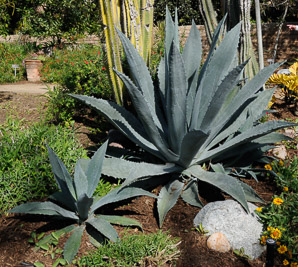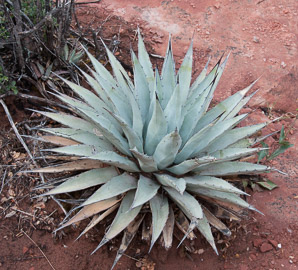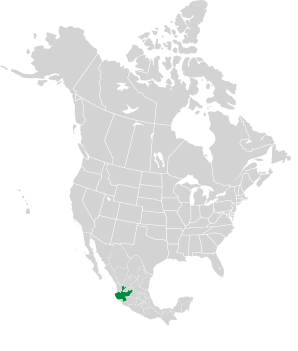
|
Agave tequilana F.A.C Weber Blue agave, Weber’s agave
Agave tequilana is native to a small area near Tequila, Jalisco, Mexico. It is now widely cultivated. Identification: This agave has a rosette 4-6′ (1.2-1.8 m) tall. Unlike most agaves, the rosette is on top of a very short stem, less than 6″ (15 cm) tall and looking a little like a crushed pineapple. Rigid, swordlike, blue-gray or green-gray leaves form a nearly perfect circle. Leaves are lined with regularly spaced teeth, and are 3-4′ (88-119 cm) long and 3-5″ (7.6-12 cm) wide. The flowering spike is 16-20′ (4.9-6.1 m) tall, with 20-25 branches. Flowers are green, with red stamens. Edibility: Blue agave is best known as the only agave that may be used to make tequila, named after the town where the plant grows naturally. The same substance that is fermented to produce tequila, called fructosan, can be substituted for sugar by those, such as diabetics, on a low-glycemic diet. The fructosan tastes much sweeter than sugar, but does not cause the spike in glucose levels that simpler sugars cause. References:
Irish, Mary & Irish, Gary, Agaves, Yuccas and Related Plants: A Gardener’s Guide, Timber Press, 2000, p. 171 Online References:
PlantWorlds (great photos) Forest and Kim Starr’s Starr Environmental site
Agave tequilana description by Thomas H. Kent, last updated 25 May 2020. © FloraFinder.org. All rights reserved. |
2/24/2010 · San Diego (Quail) Botanic Garden, Encinitas, California 5/22/2009 · Slide Rock State Park, Sedona, Arizona · ≈ 3½ × 2½′ (116 × 77 cm) Range: Zones 9b-11:
|




